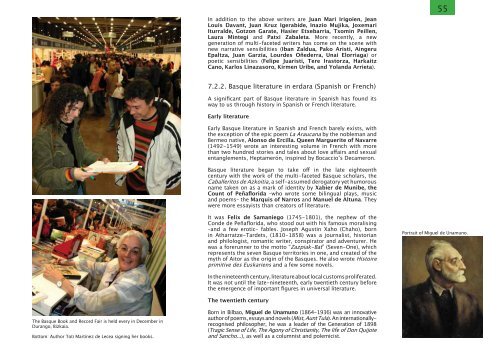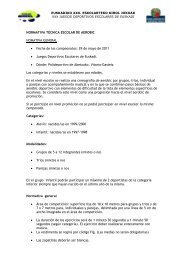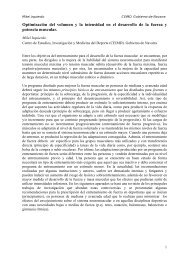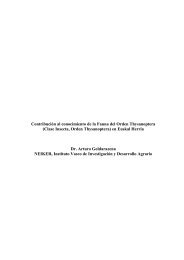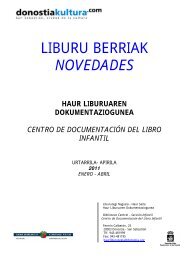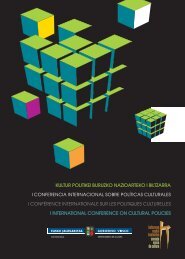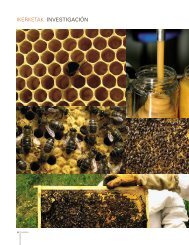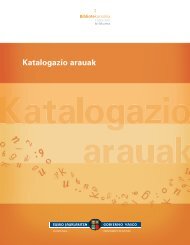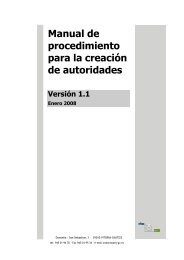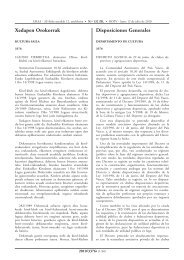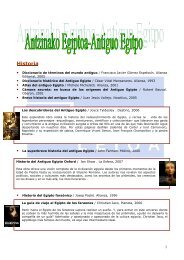The Basque Country (pdf, 4,3Mb) - Kultura Saila - Euskadi.net
The Basque Country (pdf, 4,3Mb) - Kultura Saila - Euskadi.net
The Basque Country (pdf, 4,3Mb) - Kultura Saila - Euskadi.net
Create successful ePaper yourself
Turn your PDF publications into a flip-book with our unique Google optimized e-Paper software.
In addition to the above writers are Juan Mari Irigoien, Jean<br />
Louis Davant, Juan Kruz Igerabide, Inazio Mujika, Joxemari<br />
Iturralde, Gotzon Garate, Hasier Etxebarria, Txomin Peillen,<br />
Laura Mintegi and Patxi Zabaleta. More recently, a new<br />
generation of multi-faceted writers has come on the scene with<br />
new narrative sensibilities (Iban Zaldua, Pako Aristi, Aingeru<br />
Epaltza, Juan Garzia, Lourdes Oñederra, Unai Elorriaga) or<br />
poetic sensibilities (Felipe Juaristi, Tere Irastorza, Harkaitz<br />
Cano, Karlos Linazasoro, Kirmen Uribe, and Yolanda Arrieta).<br />
55<br />
7.2.2. <strong>Basque</strong> literature in erdara (Spanish or French)<br />
A significant part of <strong>Basque</strong> literature in Spanish has found its<br />
way to us through history in Spanish or French literature.<br />
Early literature<br />
Early <strong>Basque</strong> literature in Spanish and French barely exists, with<br />
the exception of the epic poem La Araucana by the nobleman and<br />
Bermeo native, Alonso de Ercilla. Queen Marguerite of Navarre<br />
(1492-1549) wrote an interesting volume in French with more<br />
than two hundred stories and tales about love affairs and sexual<br />
entanglements, Heptamerón, inspired by Bocaccioʼs Decameron.<br />
<strong>Basque</strong> literature began to take off in the late eighteenth<br />
century with the work of the multi-faceted <strong>Basque</strong> scholars, the<br />
Caballeritos de Azkoitia, a self-assumed derogatory yet humorous<br />
name taken on as a mark of identity by Xabier de Munibe, the<br />
Count of Peñaflorida –who wrote some bilingual plays, music<br />
and poems– the Marquis of Narros and Manuel de Altuna. <strong>The</strong>y<br />
were more essayists than creators of literature.<br />
It was Felix de Samaniego (1745-1801), the nephew of the<br />
Conde de Peñaflorida, who stood out with his famous moralising<br />
–and a few erotic– fables. Joseph Agustin Xaho (Chaho), born<br />
in Atharratze-Tardets, (1810-1858) was a journalist, historian<br />
and philologist, romantic writer, conspirator and adventurer. He<br />
was a forerunner to the motto “Zazpiak-Bat” (Seven-One), which<br />
represents the seven <strong>Basque</strong> territories in one, and created of the<br />
myth of Aitor as the origin of the <strong>Basque</strong>s. He also wrote Histoire<br />
primitive des Euskariens and a few some novels.<br />
Portrait of Miguel de Unamuno.<br />
In the ni<strong>net</strong>eenth century, literature about local customs proliferated.<br />
It was not until the late-ni<strong>net</strong>eenth, early twentieth century before<br />
the emergence of important figures in universal literature.<br />
<strong>The</strong> twentieth century<br />
<strong>The</strong> <strong>Basque</strong> Book and Record Fair is held every in December in<br />
Durango, Bizkaia.<br />
Bottom: Author Toti Martínez de Lecea signing her books.<br />
Born in Bilbao, Miguel de Unamuno (1864-1936) was an innovative<br />
author of poems, essays and novels (Mist, Aunt Tula). An internationallyrecognised<br />
philosopher, he was a leader of the Generation of 1898<br />
(Tragic Sense of Life, <strong>The</strong> Agony of Christianity, <strong>The</strong> life of Don Quijote<br />
and Sancho...), as well as a columnist and polemicist.


